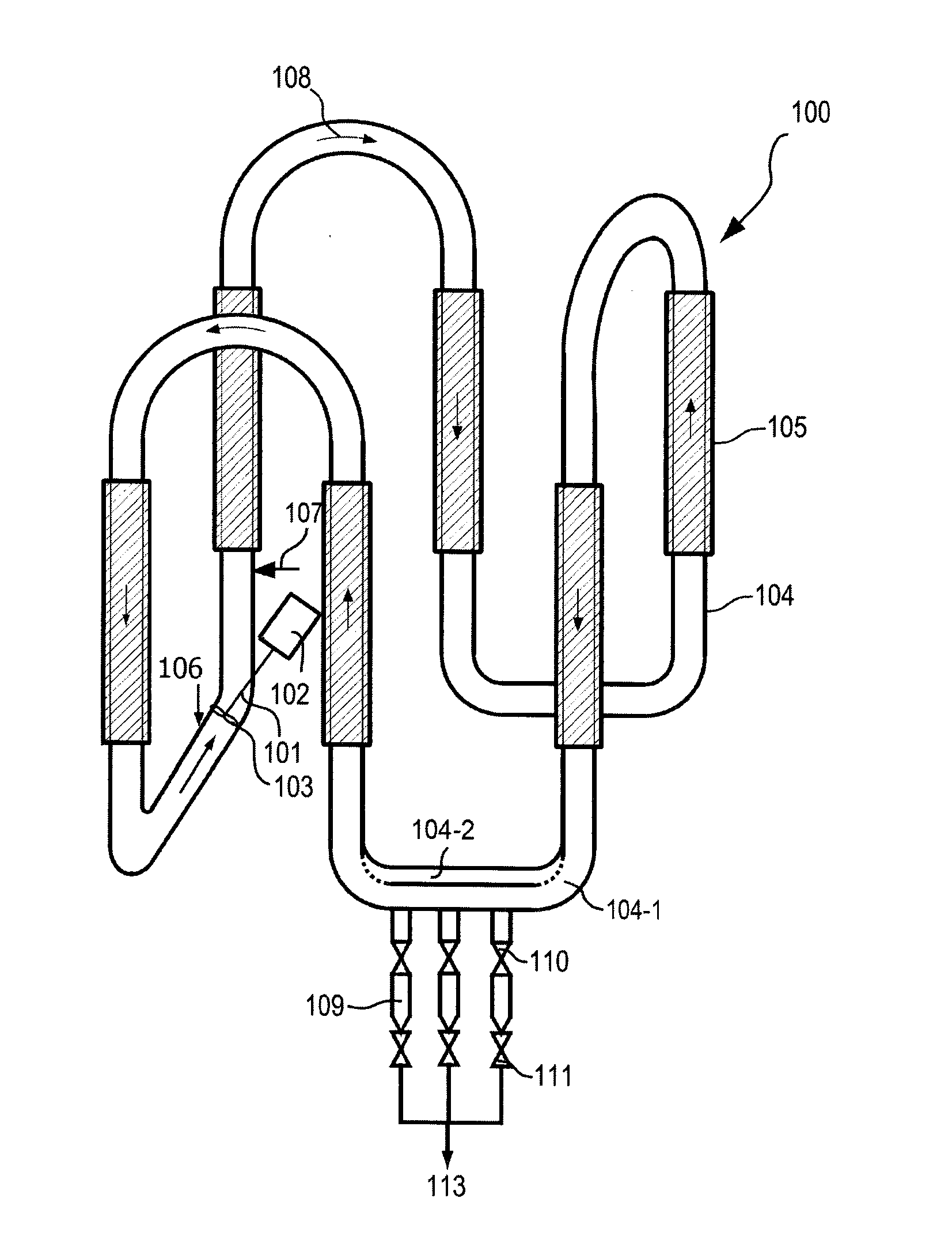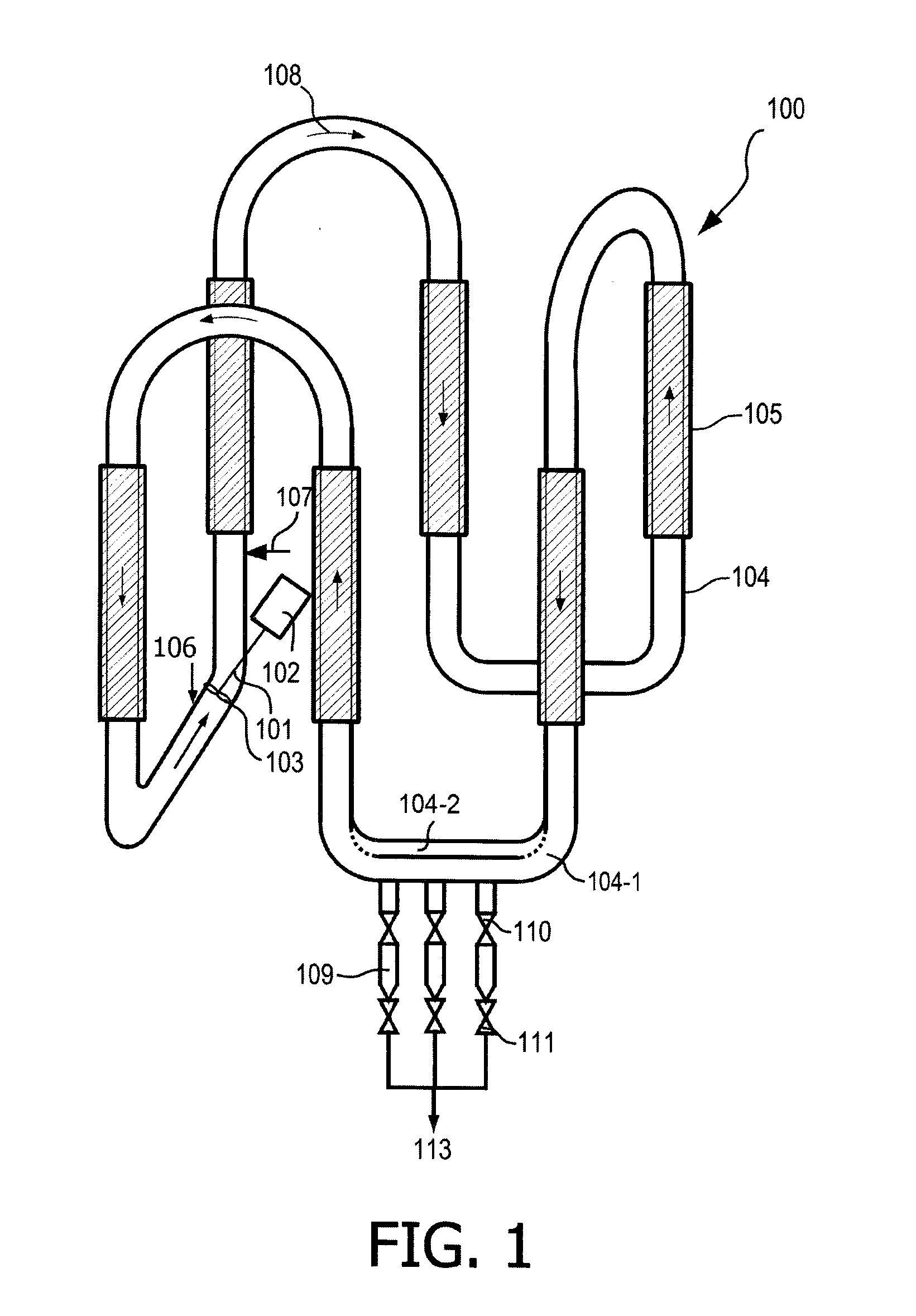Process for Preparing a Polyethylene Product in a Polymerization Loop Reactor
a technology of polyethylene product and polymerization loop, which is applied in the direction of chemical/physical/physical-chemical stationary reactors, chemical apparatus and processes, chemical/physical/physical-chemical processes, etc., can solve the problem of minor increase in the concentration of solid polymer withdrawn from the polymerization loop reactor, and achieves the effect of increasing the efficiency of the settling legs, reducing the concentration, and increasing the solid polymer concentration
- Summary
- Abstract
- Description
- Claims
- Application Information
AI Technical Summary
Benefits of technology
Problems solved by technology
Method used
Image
Examples
example 1
[0095]Polyethylene is prepared by feeding ethylene monomer, catalyst, hexene comonomer, hydrogen, and isobutane diluent to a single slurry loop reactor. The loop reactor comprises 4 vertical pipes, 2 upper horizontal segments and 2 lower horizontal segments of reactor piping, joined end to end by junctions such as elbows to form a complete loop. The developed length of the reactor is about 250 m. The vertical sections of the pipe segments are provided with heat jackets. The polymer slurry is circulated by an impeller driven by a motor. One of the horizontal segments is provided with 4 settling legs.
[0096]In this example, the desired effect is obtained by reducing the circulation velocity of the polyethylene slurry from 9 m / s in the remaining sections of the loop reactor to 5 m / s in the settling legs section. This velocity reduction is achieved by increasing the reactor inside diameter from 56.0 cm in the remaining sections of the reactor to 75.0 cm in the settling legs section. The ...
example 2
[0097]Polyethylene is prepared by feeding ethylene monomer, catalyst, hexene comonomer, hydrogen, and isobutane diluent to a single slurry loop reactor. The loop reactor comprises 4 vertical pipes, 2 upper horizontal segments and 3 lower horizontal segments of reactor piping, joined end to end by junctions such as elbows to form a complete loop. The bottom ends of two vertical pipes are connected to each other by two horizontal pipes, each provided with 3 settling legs. The vertical sections of the pipe segments are provided with heat jackets. The polymer slurry is circulated by an impeller driven by a motor.
[0098]The desired effect is obtained by reducing the circulation velocity of the polyethylene slurry from 9.5 m / s in all sections of the loop reactor to 5.5 m / s in the settling legs section, while keeping 9.5 m / s in the remaining sections of the reactor. This velocity reduction is achieved by splitting the flow in the settlings legs section into 2 horizontal sections, both equip...
PUM
| Property | Measurement | Unit |
|---|---|---|
| velocity | aaaaa | aaaaa |
| internal diameter | aaaaa | aaaaa |
| circulation velocity | aaaaa | aaaaa |
Abstract
Description
Claims
Application Information
 Login to View More
Login to View More - R&D
- Intellectual Property
- Life Sciences
- Materials
- Tech Scout
- Unparalleled Data Quality
- Higher Quality Content
- 60% Fewer Hallucinations
Browse by: Latest US Patents, China's latest patents, Technical Efficacy Thesaurus, Application Domain, Technology Topic, Popular Technical Reports.
© 2025 PatSnap. All rights reserved.Legal|Privacy policy|Modern Slavery Act Transparency Statement|Sitemap|About US| Contact US: help@patsnap.com



